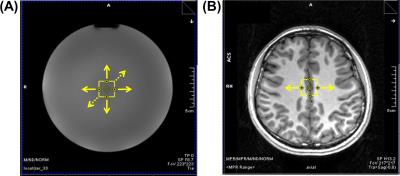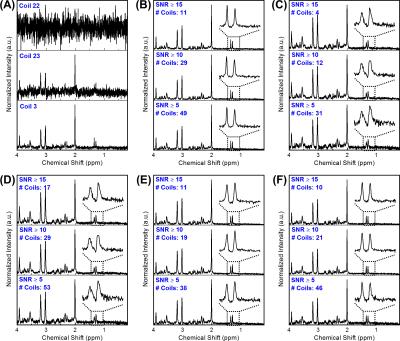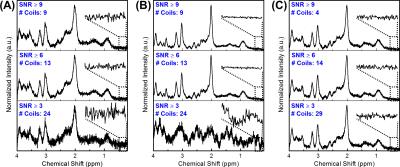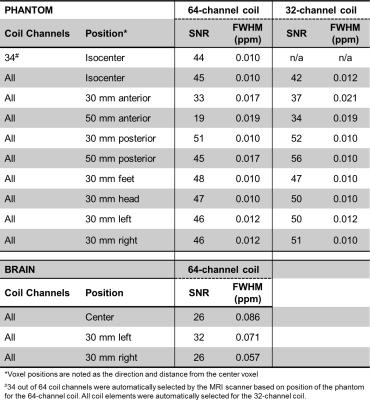5608
Effect of Coil Proximity on Parallel Spectroscopic Data Collection with Phased Array Coils1Department of Radiology and Imaging Sciences, Emory University, Atlanta, GA, United States, 2MR R&D Collaborations, Siemens Healthcare, Atlanta, GA, United States
Synopsis
Parallel imaging and spectroscopy are facilitated by multi-channel phased array coils. An important step is the combination of individual data from each channel, yet the effect of the non-uniformity of array coils on signal-to-noise ratio (SNR) is poorly characterized. Here, we present a systematic framework for identifying vulnerabilities in phased array coils for MRS. We demonstrate the importance of voxel position and coil proximity on overall SNR in a phantom and human subject, with significant SNR improvements after selectively filtering individual spectra based on pre-determined SNR thresholds which must be optimized for each phased array coil and volume of interest.
Introduction
Parallel imaging with phased array coils is widely implemented in MRI to improve efficiency and accelerate acquisition.1-2 Phased array coils require the combination of data collected from individual coil channels to maximize the signal-to-noise ratio (SNR).3-4 However, SNR variations in MRS due to the non-uniformity of each coil, particularly the proximity of individual coil channels relative to the volume of interest are not well understood. Here, we systematically investigate the effect of the number and placement of individual coil channels and voxel position on spectral SNR in a brain spectroscopy phantom and human subject.Methods
Single voxel MRS was acquired in a brain spectroscopy phantom (GE #2152220) using a 32-channel head-array coil on a Siemens 3 T Tim Trio and a 64-channel head and neck-array coil on a Siemens 3 T Prisma (Siemens Healthcare, Erlangen, Germany) with the following parameters: TR/TE/averages: 2s/30ms/64; 1200 Hz bandwidth; 2048 complex data points; 2x2x2cm3 voxel size. With IRB approved informed consent, brain spectra were acquired in a healthy human subject (female, 20 years old) with the 64-channel coil (Prisma) using the same parameters except with 128 averages. For phantom experiments, the voxel position was systematically shifted by 30 mm in the left, right, anterior, posterior, head, and feet directions and 50 mm in anterior and posterior directions. For data acquisition in the human brain, voxel position was shifted by 30 mm in the left and right directions (Figure 1). SNR and peak full-width at half maximum (FWHM) were used as spectral quality measures. Data was processed with LCModel (version 6.3-1H) and Matlab (Mathworks, Natick, MA, R2015a). Comparison of 32- and 64-channel array coils was performed using the vendor-supplied automated combination algorithm3 and a paired two-tailed t-test. For the 64-channel coil, data was acquired from either the 34 channels automatically selected by the software based on the position of the phantom or from all 64 channels manually selected. Spectra from each coil channel were processed individually and selectively combined. Specifically, individual spectra above a SNR threshold were combined with equal weighting and those below the threshold were excluded from the final combined spectrum. The % change in SNR of the combined spectrum relative to the maximum SNR for that position was calculated as: (SNR – SNRmax)/SNRmax *100%. Comparisons of the combined spectral SNR as a function of position and SNR threshold were performed using ANOVA and a post-hoc Tukey’s two-tailed t-test.Results and Discussion
Table 1 summarizes the results of data collected from multiple voxel positions using the 32- and 64-channel array coils along with data acquired in the human subject with the 64-channel coil, with spectra from individual channels combined using the vendor-supplied algorithm.3 No significant difference was observed for peak FWHM (32-channel: 0.0127 ± 0.0043 ppm; 64-channel: 0.0130 ± 0.0036 ppm; p>.05). While both phased array coils produced high spectral quality, the 32-channel coil produced significantly higher overall mean SNR and lower standard deviation (47 ± 7) than the 64-channel coil (42 ± 10; p<.05), demonstrating that simply increasing the number of phased array channels does not necessarily lead to higher SNR. As the coil channels are not uniformly arranged spatially (i.e. 32-channel coil contains 20 posterior and 12 anterior channels), and the location of the volume of interest varies in practice, combining data from all coil channels may not be optimal particularly when including channels with poor SNR (Figure 2A). We observed that overall SNR was a function of voxel position (F=49.9, p=.002) at a given SNR threshold (≥5, 10, or 15). The change in overall SNR was dependent on the SNR threshold (F=6.0, p=.03, Table 2). Tukey’s post-hoc t-tests revealed that relative to the threshold of SNR≥5, both SNR≥10 (t=4.1, p<.05) and SNR≥15 (t=4.4, p=.04) thresholds produced combined spectra with significantly higher SNR. The difference between thresholds of SNR≥10 and SNR≥15 was not significant (t=0.2, p>.05). Representative combined spectra acquired in a phantom and a human subject at varying SNR thresholds and voxel positions are shown in Figures 2 and 3, respectively.Conclusions
Our results demonstrate the importance of considering coil non-uniformity, position of individual coil channels, and data combination strategies in order to improve spectral quality and increase SNR with array coils. Overall SNR of spectra collected from phased array coils can be increased by combining spectra with high SNR and discarding those with poor SNR at a pre-determined threshold which must be optimized for each array coil and volume of interest. Future studies will focus on developing improved automated algorithms for phased array coil combination.Acknowledgements
This work was supported by NIH 1R01CA169937.References
1. Roemer, PB et al. The NMR phased array. Magn Reson Med. 1990;16:192-225.
2. Deshmane, A. et al. Parallel MR imaging. J Magn Reson Imaging. 2012;36:55-72.
3. Brown, MA Time-domain combination of MR spectroscopy data acquired using phased-array coils. Magn Reson Med. 2004;52:1207-1213.
4. Abdoli, A and Maudsley, AA. Phased-array combination for MR spectroscopic imaging using a water reference. Magn Reson Med. 2016;76:733-741.
Figures




